SwitchBot K10+ Pro: two-minute review
If you want a compact robotic vacuum cleaner, the pint-sized SwitchBot Mini Robot Vacuum K10+ Pro could be just what you’re looking for. Don’t be put off by the diminutive design – this robot vacuum is packed with tech, from intelligent room-mapping and app control, to self-emptying and some of the quickest navigation we’ve ever seen.
It squeezes with confidence – and often at speed – between furniture legs, cleaning carpet inaccessible by larger robots, and the equally compact dock will appeal to those with small apartments, too. It also taps into SwitchBot’s existing smart home ecosystem, and can be controlled by voice via Alexa or Google Assistant.
However, this small robot’s suction power isn’t a match for bigger, pricier rivals, and the mopping function – which merely drags a disposable wet wipe across the floor – failed to impress. As with many robot vacuums, you need to watch out for high doorway thresholds, as anything over 20 mm will be a struggle for the K10+ Pro to clear consistently (although some of today’s best robot vacuums don’t have such an issue with this, thanks to some new and innovative engineering solutions) .
Those factors aside, this compact vacuum is still a good option for smaller, mostly carpeted homes, or for focusing on specific zones of larger properties. Install it upstairs, away from the tougher challenges of the kitchen and hallway, and your guest bedrooms will be spotless, while giving up precious little space for the robot and its dock.
That’s the short version; read on for my full SwitchBot K10+ Mini Robot Vacuum review.
SwitchBot K10+ Pro review: price & availability
- List price: $599.99 / £599.99
- Launched: August 2024
- Available: US / UK
The $599.99 / £599.99 K10+ Pro sits above the regular $399.99 / £399.99 K10+ in SwitchBot’s lineup of mini robotic vacuum cleaners, but some way below the flagship S10, which costs $1,199.99 / £1,099.99.
It looks almost identical to the K10+ but the Pro model gains a set of useful extra features, including a PSD distance sensor for more accurate navigation, a silicon anti-tangle brush, and a 3,000Pa suction system (20 percent more powerful than the K10+). It also benefits from an antibacterial dustbag, which the regular K10+ lacks.
A price difference of $200 / £200 is fairly significant at this end of the robotic vacuum market, especially when the two robots look almost exactly the same. But pet-owners will surely be drawn to the anti-tangle brush of the Pro, along with the extra suction power.
The K10+ Pro’s price puts it roughly on par with other mid-range robotic vacuum like the Roomba Combo J5 Combo from iRobot. That model also works as a mop, but it too requires the user to manually swap the mopping attachment in and out to switch between the vacuum and mop functions. Unlike the SwitchBot and its disposable wet wipes, the Roomba has a washable and reusable (then eventually replaceable) mopping cloth.
The SwitchBot’s price falls between the Eufy Clean X8 Pro (which acts only as a vacuum with self-emptying bin), and the pricier Eufy X10 Pro Omni, which has a rotating and self-cleaning mop.
While not uncomfortably expensive, the SwitchBot K10+ Pro feels like it charges a premium for its compact size. Instead of being a smaller and therefore cheaper model, it sells its dimensions as a benefit rather than a byproduct. That’s mostly fine, but this price point causes the SwitchBot to fall between two categories of robot – ones that only vacuum, and ones that also mop. At 3,000Pa, the suction is fine but a little below what other models at this kind of price point offer.
Buyers will need to decide if they value the compact size above all else. Or, if they would rather spend less and lose the mop, or pay more for a robot that puts a greater emphasis on mopping.
- Value for money score: 3.5 out of 5
SwitchBot K10+ Pro specs
| Suction: | 3,000Pa |
| Robot diameter: | 9.76″ / 24.8cm |
| Robot height: | 3.62″ / 9.2cm |
| Dock dimensions (W x D x H): | 10.28 in x 8.27 x 12.72″ / 26.1 x 21 x 32.3cm |
| Mopping: | Wet wipe, no water tanks |
| Dock: | Self-empty dust |
| Dust bin volume (onboard): | 0.2L |
| Dust bin volume (base): | 4L |
| Wi-Fi control: | Yes |
SwitchBot K10+ Pro review: design
- Shallow and compact design
- Self-empties dust into the (also compact) dock
- Unusually, the mop relies on disposable wet wipes
Based on photos alone, you might think the K10+ Pro looks like any other robotic vacuum, but when you see it in person you realize just how compact it really is. It’s a circular robot with a diameter of just 9.76 in (24.8cm) – compared to 13.39 in (34cm) for the SwitchBot S1 Plus – and a height, including the top-mounted radar, of 3.62 in (9.2cm). These diminutive dimensions help the SwitchBot drive between and under furniture in ways larger robots cannot.
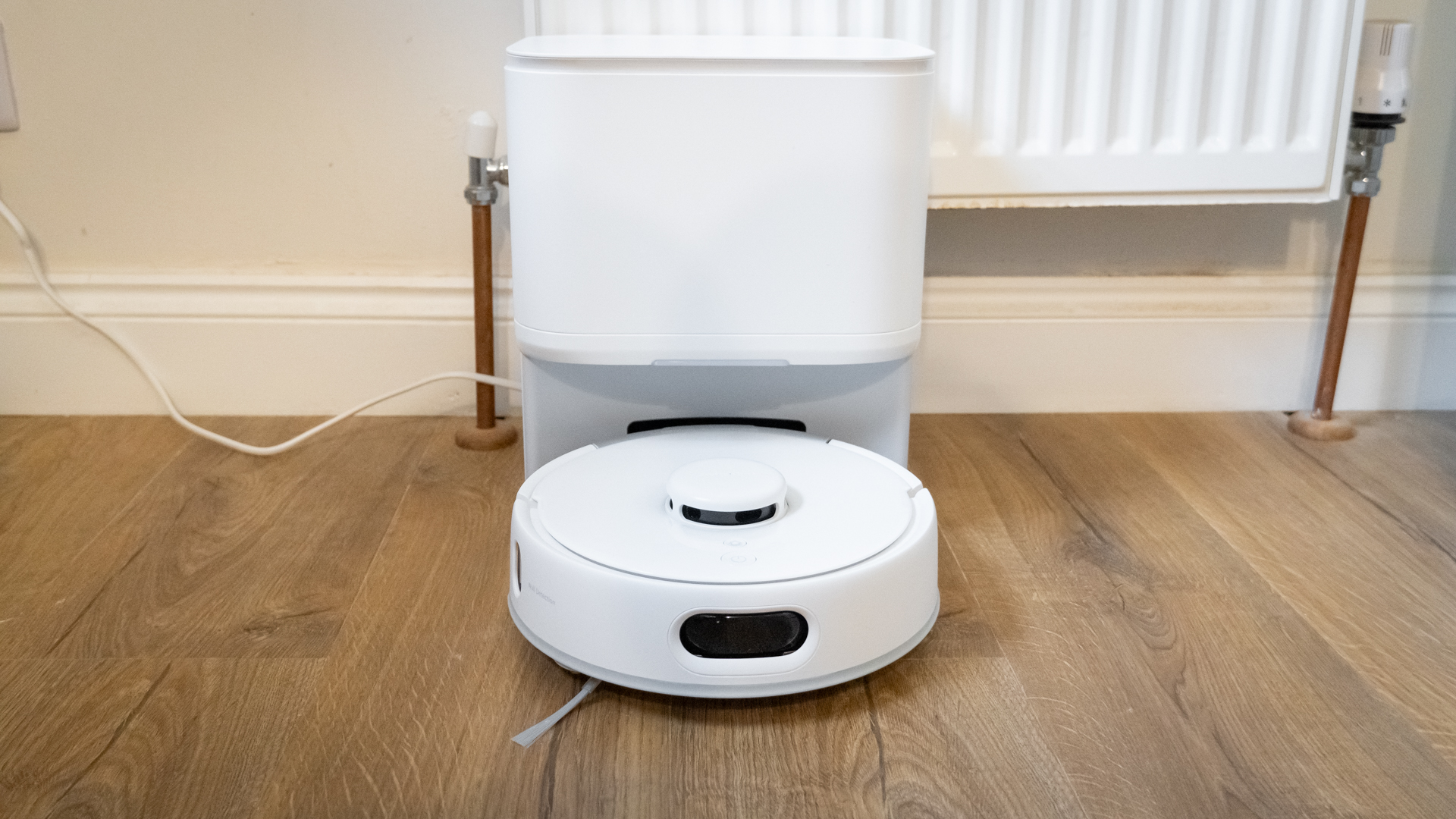
The docking station and dust bin is also smaller than most of its rivals. It’s so compact, SwitchBot suggests you could even tuck it under a chair. The all-round diminutive size makes the K10+ Pro ideal for smaller homes, or even as a second robotic vacuum tasked with cleaning lesser-used parts of a larger home, such as the spare bedrooms or office.
The robot itself has a radar on top, plus sensors on its front and side, and a cliff sensor underneath, to help navigate without crashing, getting stuck or falling down the stairs. There are just two buttons on the robot, for powering it on or off and telling it to go back to its charger. Every other function is controlled by the SwitchBot smartphone app, which is free for iOS and Android.
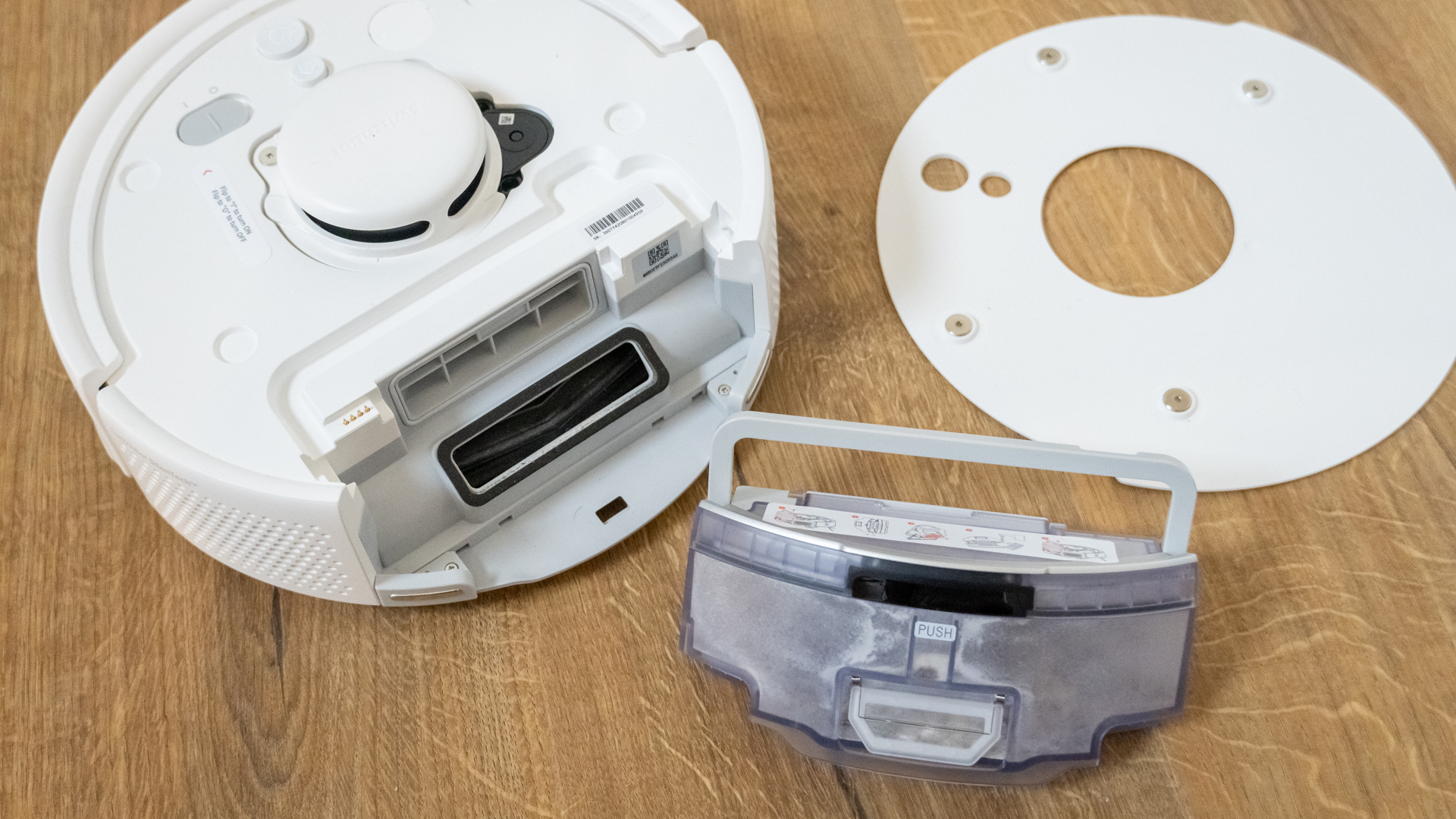
The top cover is secured by magnets, and when removed reveals a power switch that’s only needed during the initial setup process, and the dust bin. The bin’s filter is easy to remove and clean, and handily the smartphone app notifies you when the bin has been removed or replaced.
Turn the K10+ Pro over and you’ll find a spinning side brush for flicking dust and dirt out from corners of the room, and a rotating anti-tangle brush made from rubber. During my month of testing the brush didn’t once get tangled up, although a fair bit of hair collected at either side. Thankfully this doesn’t restrict its movement, and is easy to extricate by removing the roller and snipping at the hair with some scissors.
The robot comes with a mopping attachment, which is fitted manually to its underside and, rather unusually, uses wet wipes instead of a washable pad or cloth. SwitchBot says this is an improvement over robotic vacuum cleaners that use washable towels for their mops, since it employs a clean wipe every time. I can see the logic here, but fitting a new disposal wipe after every mop seems wasteful.
Either way, the K10+ Pro won’t give your hard floors a particularly deep clean, since the wipes are simply dragged over the surface with no real pressure behind them. If you need a mopping robot, I’d recommend upping your budget if possible and going for a model with a mechanical spinning mop, like the Eufy X10 Pro Omni or Eufy Omni S1 Pro.
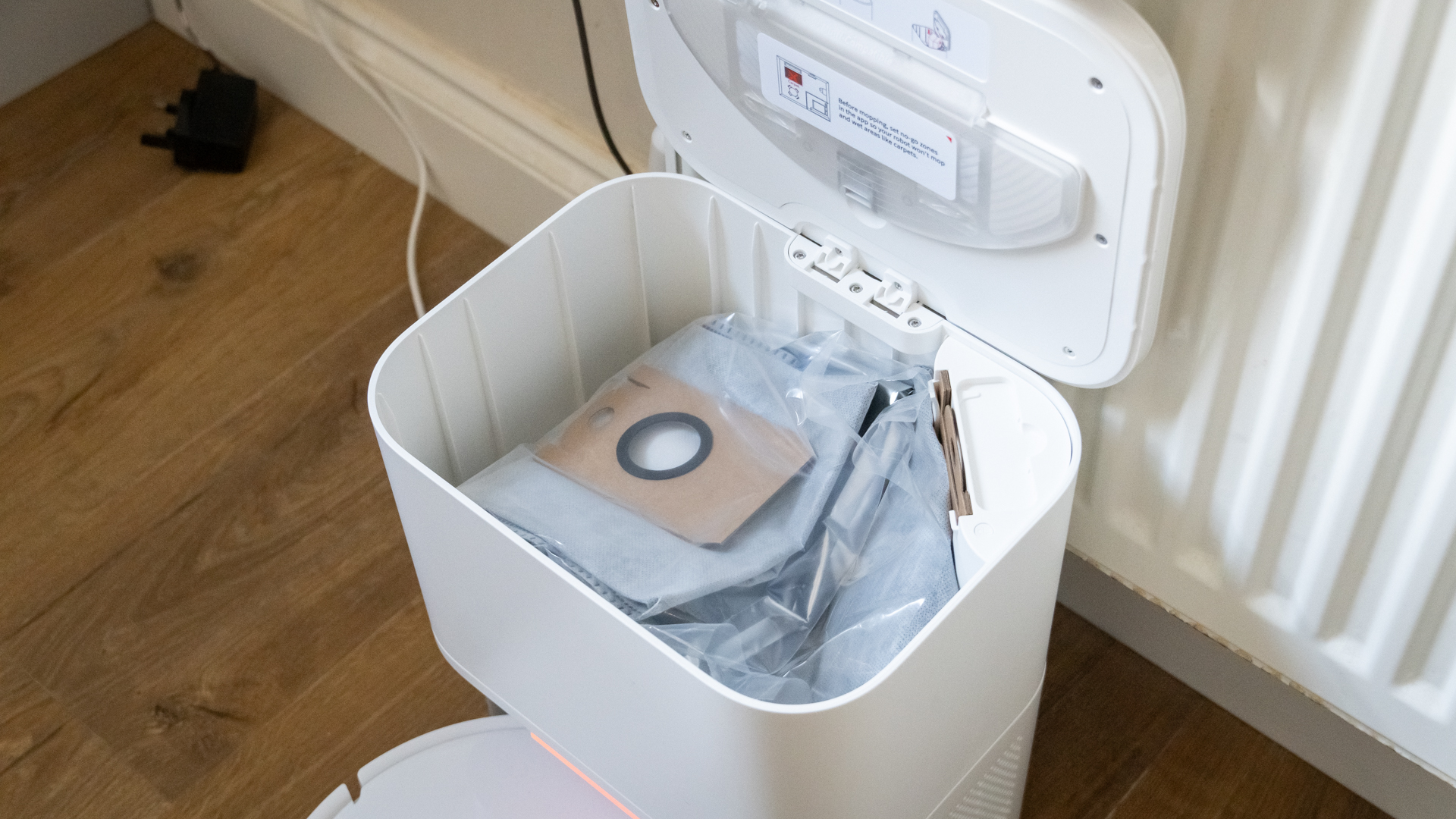
Back to the K10+ Pro, and the compact charge station houses a generous 4-liter dust bag that should last for months before it needs taking out and replacing. The robot automatically empties into the dustbag when its own bin gets full (at a brief but rather loud 83dB), but there’s no water supply for the mop, since it uses wet wipes instead.
Although compact, the top-opening charge dock is plenty large enough to house a spare dust bag and filter, plus a pack of wet wipes and a brush for detangling the robot – all of which is included in the box. It makes for a handy way of storing everything associated with the K10+ Pro, instead of inevitably losing its various components in a cupboard elsewhere.
- Design score: 4.5 out of 5
SwitchBot K10+ Pro review: performance
- Quiet, with moderate suction power
- Mop function is not worth the effort
- Good but not infallible navigation
Before I conducted a set of controlled tests with the K10+ Pro, I set it up and simply used it as my vacuum cleaner. The setup process is quick and easy. Just download the SwitchBot app, follow the instructions to connect the robot to your Wi-Fi network (this step failed at first, then worked fine when I tried again), and let it map your home.
I used the app to name each room and adjust the room boundaries slightly. The robot did a decent job of working out where room thresholds were, but got a bit confused by a hallway connecting the kitchen, bathroom, lounge and bedroom. A couple of minutes of tinkering in the app, and the map was perfect.
I was particularly impressed by how it confidently drove under a bathroom cupboard with less than 0.4 in (1cm) of clearance without even a moment of hesitation. I also liked how it could drive itself between the three legs of a table I have next to my sofa. Other, larger robots can’t fit through here, or between the legs of my office chair, so the floor between the legs is always missed. Not so with the smaller SwitchBot.
However, while its navigation is mostly very good – and it really is capable of getting to places larger vacuums can’t – it repeatedly drove at full speed into a fireplace hearth. This made me question the SwitchBot’s intelligence, but I saw no other collisions during the mapping and cleaning process.
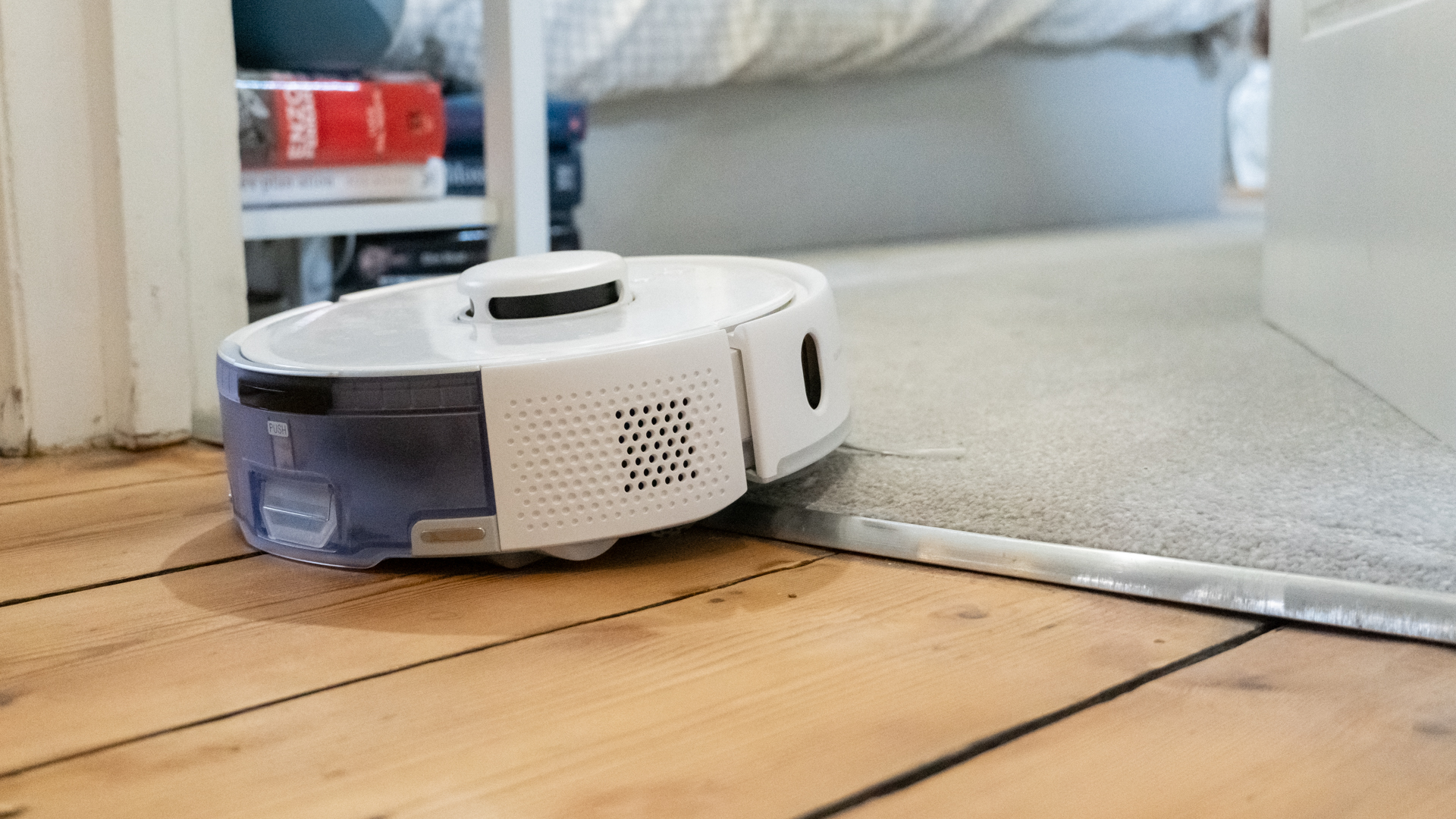
The K10+ Pro is quite good at driving over high thresholds, which have been a problem for much more expensive robotic vacuums in the past, like the Eufy S1 Pro. The SwitchBot sometimes had to back up and try a different angle, but it very rarely failed to clamber over what is a rather high threshold between my hallway and kitchen.
The same gung-ho approach couldn’t be replicated in the lounge, however, where it repeatedly got stuck in a thick rug. I had to mark this area as a no-go zone in the app, which was disappointing but hardly a surprise. Only one robot that I’ve tested, the Eufy X10 Pro, has so far managed to successfully wade through the rug without calling for help.
As with other robotic vacuums, the K10+ Pro can be configured to clean each area once or twice, and there are four suction modes to pick from, called Quiet, Standard, Strong and Max. Via the app you can create a room-by-room cleaning plan, with the ability to set a suction strength and cleaning time (once or twice) for each room, before you set the robot on its merry way. It automatically increases suction power when driving from a hard floor to carpet, but doesn’t ramp up the power specifically when there’s more debris to tackle, as some more advanced robovacs can.
For everyday cleaning the K10+ Pro performed well. The app is easy to use and it takes just a couple of taps to tell the robot to clean a specific area, a certain room or the entire floor. It’s also easy to create a schedule, which is where robots like these work best. Configure it to clean high-traffic rooms frequently, and this little-and-often approach will keep your floors looking their best. Alternatively, I can see a compact robot like this being perfect for giving your spare bedrooms a weekly clean, or even taking charge of the entire upstairs, while you use a conventional vacuum in the kitchen, hallway and lounge.
Time for the more specific tests. This involves using a mix of oats and flour on hard floors and carpet, then seeing how the robot performs as we cycle through all of suction strengths and cleaning modes.
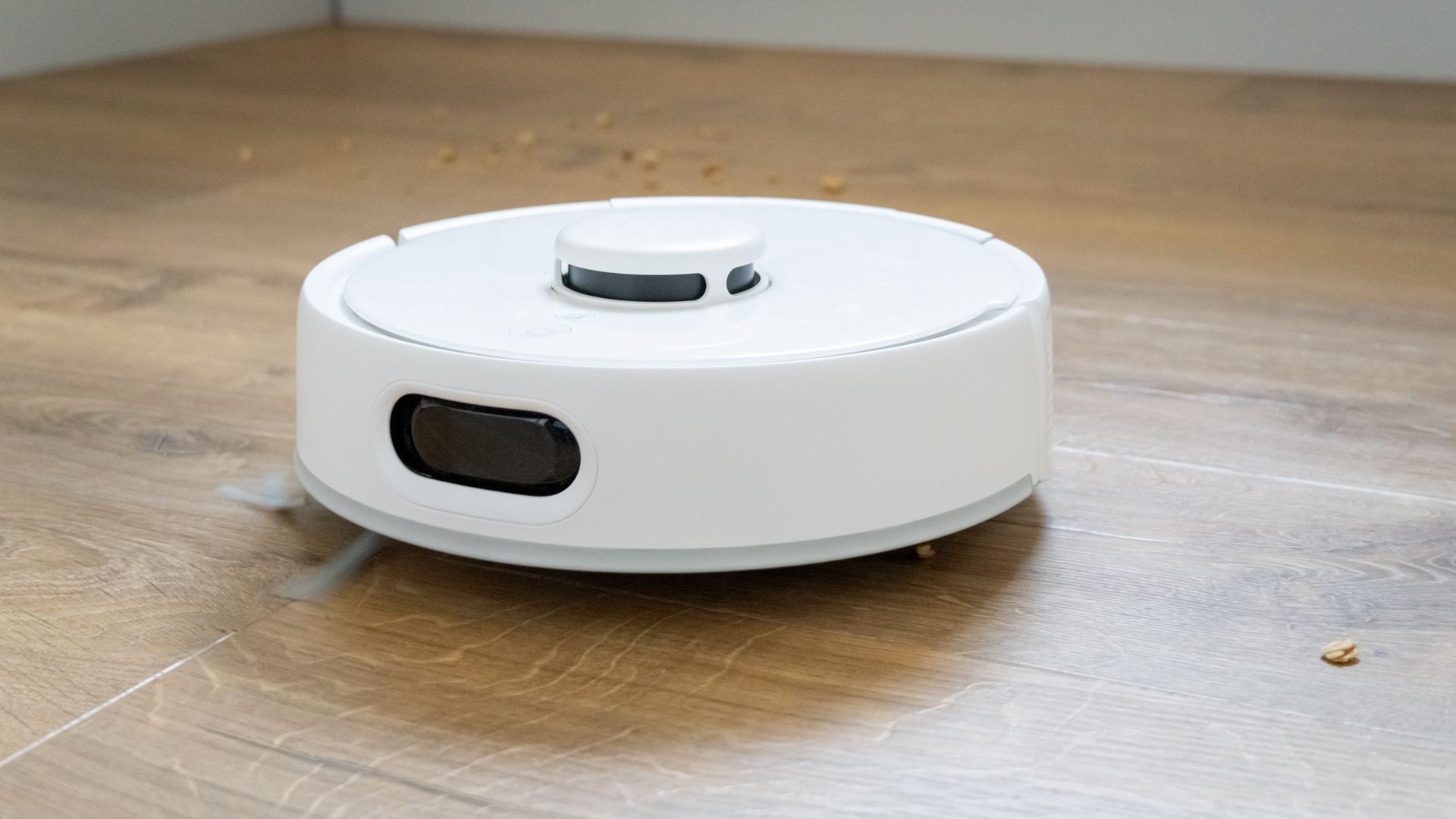
Quiet mode is fine for a light, frequently vacuum of low-traffic areas, and at just 64 dB it is remarkably quiet. It’ll pick up larger debris like oats, but as with other robotic vacuums the K10+ Pro tends to flick everything around on its first pass, rather than pick it all up. You really need to set the vacuum to pass every area twice. That way debris gets flicked around a bit initially, but is mostly collected on the second pass.
Cranking the power setting up to Max increases the volume to 70 dB, and there’s a noticeable difference in suction power. More debris is picked up on the first pass, then almost everything else is picked up the second time around. That said, the K10+ Pro still isn’t as powerful as some pricier rivals, since it offers just 3,000 Pa of suction, compared to 5,000 Pa or even 8,000 Pa for more expensive options from the likes of iRobot and Eufy. Even on maximum power it failed to suck up flour from the shallow grooves between floorboards, and had a habit of leaving arcs of flour on the floor every time it turned around.
It performed similarly on carpet, where maximum strength wasn’t quite enough to pull every bit of flour out of the floor. During this test I also found it failed to clear a circa-2cm threshold between the exposed floorboards of the hallway and the bedroom carpet. This is a common stumbling point for robotic cleaners of all prices, and despite trying for several minutes, the SwitchBot eventually failed to climb onto the carpet and called for help via the app. You’ll need to bear this in mind if you’re shopping for a robot vacuum, since very few manage this journey from floorboards to carpet reliably.
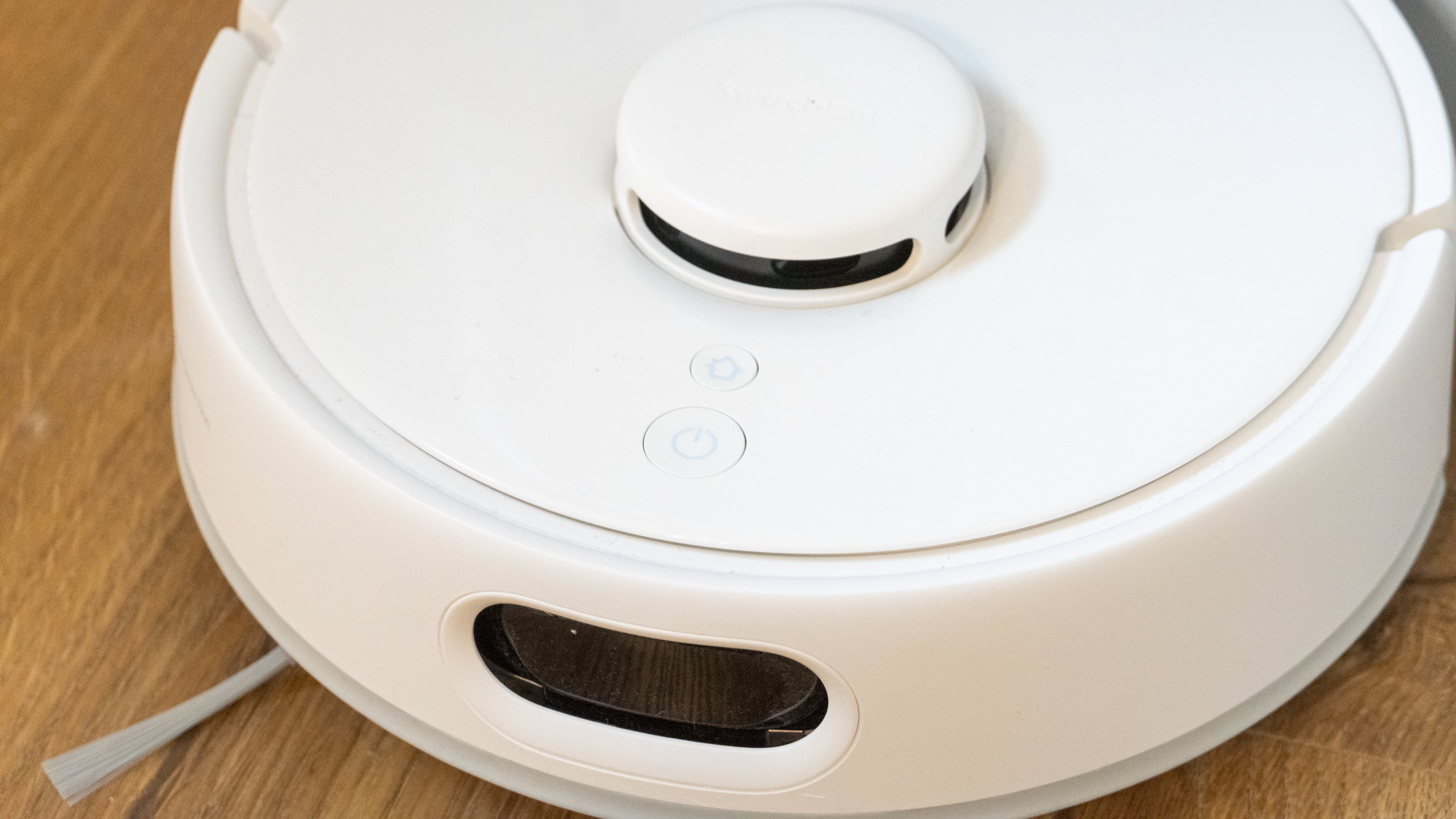
The K10+ Pro is one of the quickest robotic vacuums I’ve ever reviewed, driving faster than most others when it has the space to do so. I reckon it would easily clear the challenging thresholds if it gave itself a run-up, but SwitchBot doesn’t seem to have programmed it to do so. One for a future software update, perhaps – just so long as it can reliably distinguish between a tricky threshold and a staircase.
Generally, and thresholds aside, the K10+ Pro does a decent job of navigating between rooms. However it will occasionally drive straight into objects, like chair legs and door frames, and do so repeatedly, as if feeling instead of seeing its way around, until a clear path is discovered. Its behavior sometimes reminded me of older, less intelligent robotic vacuums. It’s unlikely to damage anything, but this headbutting approach makes the robot seem less smarter than it claims to be.
As is often the case with robotic vacuums, the K10+ Pro is good at light, frequent cleaning, but struggles to pick up absolutely everything when tasked with fixing a specific problem, like the spilled cup of oats and flour used in our tests. The debris left behind was completely removed by a regular handheld vacuum in a matter of seconds.
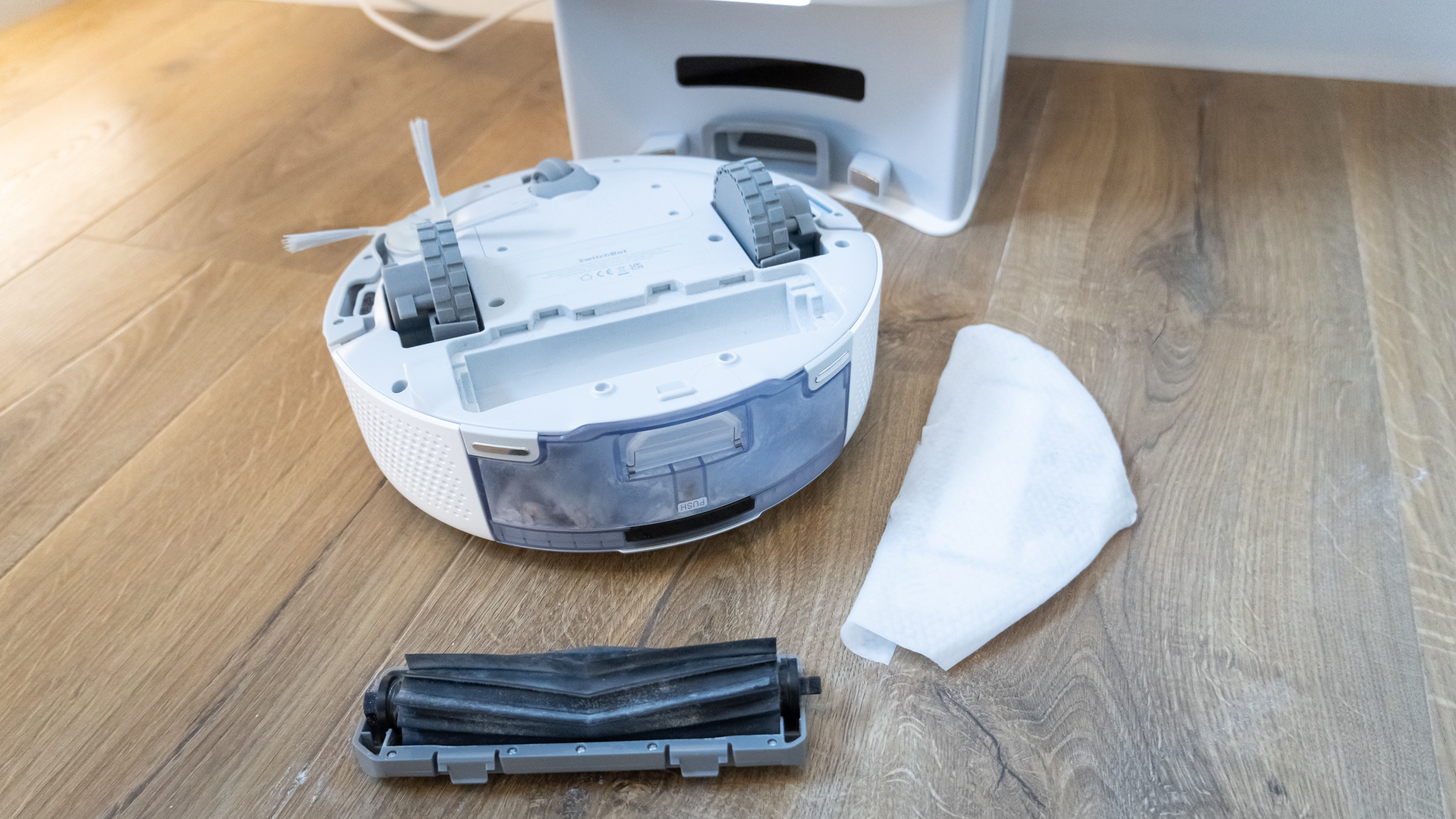
Moving to the mopping function, and this is really more of a quick wipe than a thorough scrub. More expensive robots have motorized mops that spin and push down onto the floor with real force, but here it’s just a case of fitting an included wet wipe and telling the robot to get to work. I like how the wipe holder stores neatly inside the charging dock, but fitting a fresh wipe each time is a bit of a pain.
Attaching the mop switches the robot from vacuum to mopping mode, but this is very much a manual process. You have to fit the mopping attachment (which covers the rotating rubber brush) and tell it to go mop a specific room or area, then detach it to turn the robot back into a vacuum cleaner. The rotating side brush operates in both modes.
While handy for a quick wipe, the mop isn’t capable of lifting any serious stains. In fact, it failed to fully remove some freshly split hot sauce from the kitchen floor, despite passing twice over the liquid. The wipe became dirty, so it had clearly done something, but this is really no more than a very light clean. A pack of 30 wipes is included in the box, each with a couple of holes for fixing to the mop attachment, but I can’t see many owners buying another pack when they run out.
- Performance score: 3.5 out of 5
SwitchBot K10+ Pro review: app
- Easy to use
- Lots of functionality
- Apple Home requires additional hub
This robot uses the same app as other devices made by SwitchBot, which is handy if you want to build out your smart home with the company’s devices, like door locks, motorized window blinds, security cameras and the Bot from which the firm gets its name.
You’ll need to buy a SwitchBot Hub for some of these, but the vacuum works fine on its own – although you will need that hub if you intend to control it from Apple Home via the Matter wireless standard. Incidentally, voice control via Alexa and Google Assistant works without the hub.
The setup process is quick and easy, with the robot mapping your home on its first exploratory outing. You can then use the app to split the map into rooms and name them accordingly. With that set, you can ask the robot to go clean a specific room, or create a cleaning plan where a different suction setting is used for each room. It’s also possible to draw no-go zones (such as a thick rug that the robot will get stuck in), or draw a specific area you want cleaning.
These are all common features across various robotic vacuums. There’s nothing that really makes the SwitchBot app stand out from the crowd, but it’s nice to see how the ‘Mini’ name doesn’t mean it’s lacking in features.
Should you buy the SwitchBot K10+ Pro?
| Attribute | Notes | Rating |
|---|---|---|
| Price | Not wildly overpriced, but more expensive than the regular K10+, and you’re paying a bit of a premium for the fact it’s small. | 3.5/5 |
| Design | Fantastically compact, this robot fits into places others simply can’t. This is great news for storage but also for navigation and its ability to effectively clean in tight spots. | 4.5/5 |
| Performance | Navigates well and drives remarkably quickly, with a very quiet mode available when needed. Suction power isn’t the strongest though, and the mopping feature isn’t worth the effort. | 3.5/5 |
| App | Free and simple enough to use, with the ability to build a fairly comprehensive smart home with other SwitchBot products. Apple Home control requires the SwitchBot Hub, sold separately. | 4/5 |
Buy it if…
Don’t buy it if…
How I tested the SwitchBot Mini Robot Vacuum K10+ Pro
I set up the K10+ Pro and used it as my only vacuum for a couple of weeks before starting the review. I then carried out a range of specific cleaning tasks to assess its mapping, navigation, suction and mopping abilities.
Read more about how we test
- First reviewed October 2024
Leave A Comment
You must be logged in to post a comment.